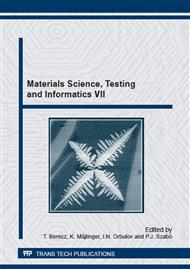[1]
H.F. Hildebrand, N. Blanchemain et al, Surface coatings for biological activation and functionalization of medical devices, Surface and Coatings Technology. EMRS 2005 Symposium K — Protective Coatings and Thin Films: 2005 May 31 – June 3: Strasbourg(FR) (2006).
DOI: 10.1016/j.surfcoat.2005.11.086
Google Scholar
[2]
G. Mani, M. D. Feldman, et al, Coronary stents: A materials perspective, Biomaterials 28 (2007) 1689-1710.
DOI: 10.1016/j.biomaterials.2006.11.042
Google Scholar
[3]
H. W. Fang, K. Y. Li, et al, Dip coating assisted polylactic acid deposition on steel surface: Film thickness affected by drag force and gravity, Material Letters (2008) 62 (21-22) 3739-3741.
DOI: 10.1016/j.matlet.2008.04.046
Google Scholar
[4]
H. Ollendorf, D. Schneider, A comparative study of adhesion test methods for hard coatings, Surface and Coatings Technology (1999) 113 (1-2) 86-102.
DOI: 10.1016/s0257-8972(98)00827-5
Google Scholar
[5]
M. El-Shabasí, Perspective of adhesion of thin films, Electrical Engineering and Computer Science, (1981) 25-2 123-134.
Google Scholar
[6]
E. V. Cortés, M. A. Lorenzo, et al, Adhesion Testing of Epoxy Coating, Texas Department of Transportation, 1998 Sept.
Google Scholar
[7]
C. S. Litteken, R. H. Dauskardt, Adhesion of polymer thin-films and patterned lines, International Journal of Fracture (2003) 119/120 475-485.
DOI: 10.1023/a:1024940132299
Google Scholar
[8]
T. L. Sélley, A. Terdik, E. Bognár, Biológiailag lebomló polimerbevonatok tapadásának vizsgálata (Investigation of biodegradable polymer coatings' adhesion test), Fiatal Műszakiak Tudományos Ülésszaka XVIII 2013 March 21–22 Kolozsvár (RO).
DOI: 10.36243/fmtu-2013.78
Google Scholar
[9]
T. Newson, Stainless Steel – A Family of Medical Device Materials, Business Briefing: Medical Device Manufacturing & Technology (2002) London (UK).
Google Scholar
[10]
R. W. Smith, New Developments and Trends in Medical-grade Adhesives, Medical Device Manufacturing & Technology (2004) London (UK).
Google Scholar
[11]
Y. Onuki, U. Bhardwaj, M. P. F. Papadimitrakopoulos, D. J. Burgess, A Review of the Biocompatibility of Implantable Devices: Current Challenges to Overcome Foreign Body Response, J Diabetes Sci Technol. (2008) November 2 (6) 1003–1015.
DOI: 10.1177/193229680800200610
Google Scholar
[12]
J. M. Anderson, M. S. Shive, Biodegradation and biocompatibility of PLA and PLGA microspheres, Advanced Drug Delivery Reviews (1997) 28 5–24.
DOI: 10.1016/s0169-409x(97)00048-3
Google Scholar
[13]
A. Raval, A. Choubey, H. Kotadia, et al, Novel Biodegradable Polymeric Matrix Coated Cardiovascular Stent For Controlled Drug Delivery, Trends Biomater. Artif. Organs (2007) 2 101-110.
Google Scholar
[14]
D. Fejős, P. Sütő, K. Molnár, B. Pukánszky, PU/PBT keverékek vizsgálata esetleges orvosi alkalmazásra, (Examination of PU / PBT blends for possible medical applications), Műanyag és Gumi (2011) 48 (12) 446-449.
Google Scholar


